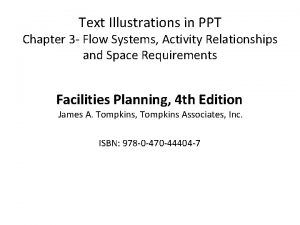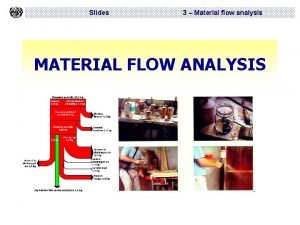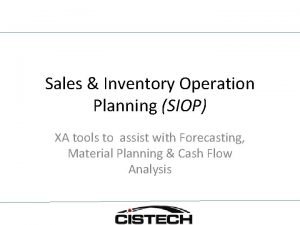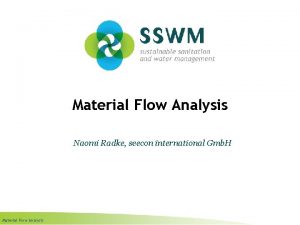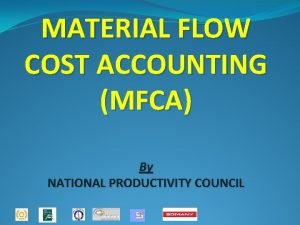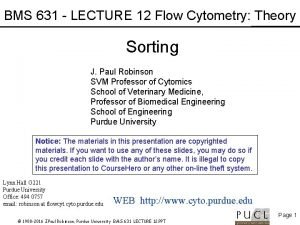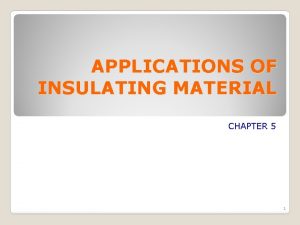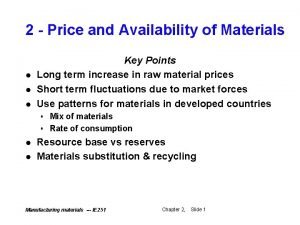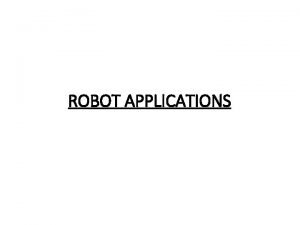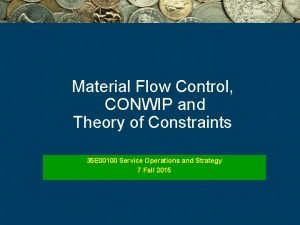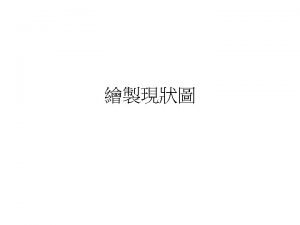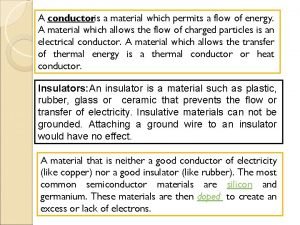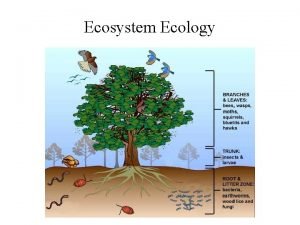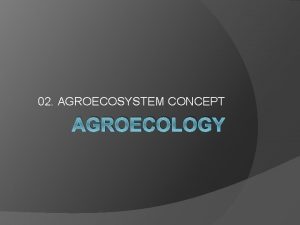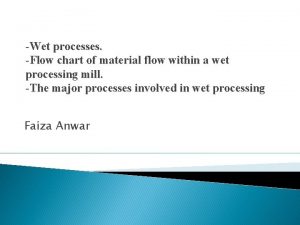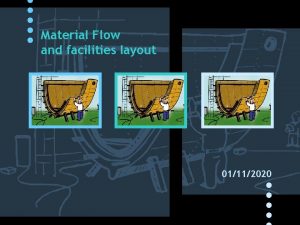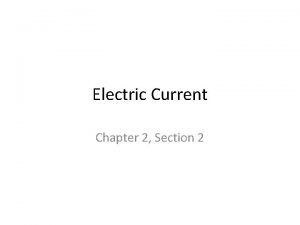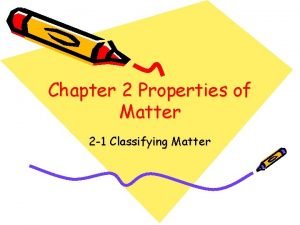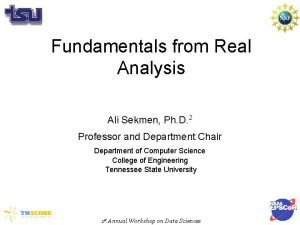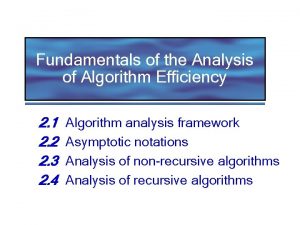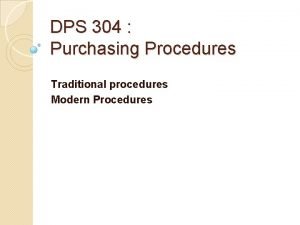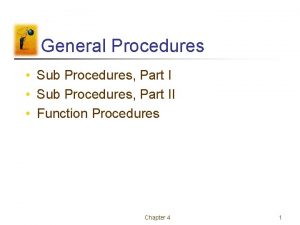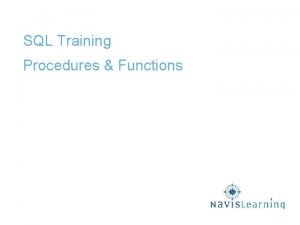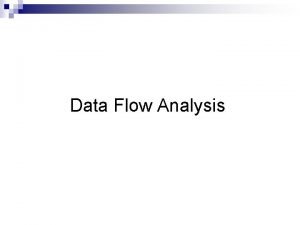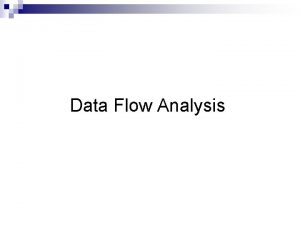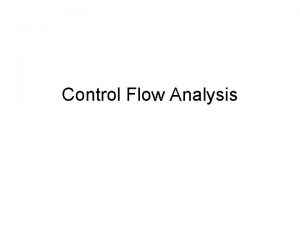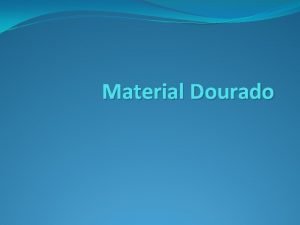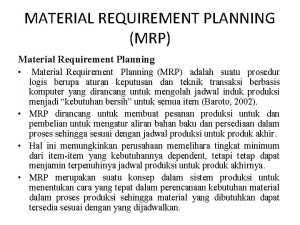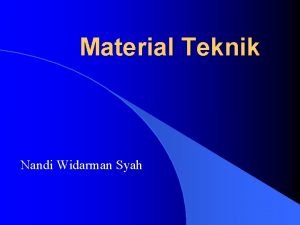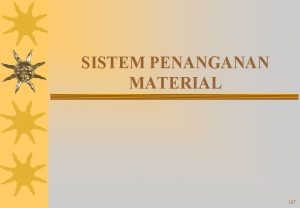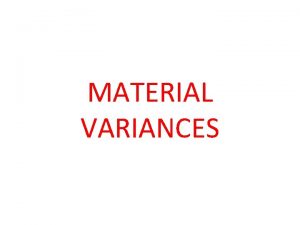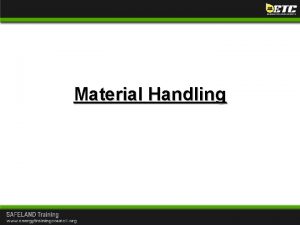Material Flow Analysis Fundamentals Lecture II Procedures Application









![Goal & Scope Selection of processes [Mining & Refining] • Bauxite mining • Alumina Goal & Scope Selection of processes [Mining & Refining] • Bauxite mining • Alumina](https://slidetodoc.com/presentation_image_h/09ba6a6db699a20fb95d285d1f560767/image-10.jpg)























- Slides: 33

Material Flow Analysis Fundamentals Lecture (II): Procedures, Application & Perspectives

Lecture (II): Procedures, applications & perspectives Index ❶ General context – Why using Material Flow Analysis? ❷What is Material Flow Analysis? ❸ How to carry out a Material Flow Analysis? • General procedure • Illustrative case study: Global aluminium cycle ❹ Perspectives & conclusions • Other types of MFA according to OECD • Other sustainability tools • Summary of the lecture 2

Lecture (II): Procedure, Application & Perspectives ❸ How to carry out a Material Flow Analysis ? General procedure 3

MFA procedure 2. Limit the balance scope 3. Limit the balance period Goal & Scope 1. Define the objectives and parameters to be monitored 4. Identify and define the process steps 5. Draw the flowcharts: material flows – quality Source: United Nations Industrial development Organization (UNIDO) Interpretation 7. Interpret the results and draw conclusions Quantification 6. Draw up the balances: material flows – quantity 4

MFA is an iterative process ! Problem definition / Research question Adjust system Goal & Scope Determination of system boundaries Selection of substances adjustment Determination/ selection of processes Determination/selection of goods Determination of flows and stocks Determination of mass flows Redefine problem Source: Practical Handbook of Material Flow Analysis, Brunner P. H. & Rechberg H. (2004) 2. Re-determine goods 1. Refine mass flows Balancing the goods 2. Refine mass flows Determination of concentration Balancing of substances 1. Refine concentrations Illustration & interpretation 5

Lecture (II): Procedure, Application & Perspectives ❸ How to carry out a Material Flow Analysis ? Illustrative case study: the global Aluminum cycle 6

Problem definition / Research question Goal & Scope “ The purpose of this study is the quantification of regional stocks and flows of stocks and flows rolled, extruded and casting alloys across space and over time, giving the industry the ability to evaluate the potential to recycle aluminium scrap most efficiently. ” Sources: Asland aluminium, creative commons 7

Goal & Scope Selection of goods & substance • Targeted substance: Aluminium 13 Al • Goods: – Primary Aluminium 26, 98 – Recycled Aluminium – Alumina – Bauxite – New and old scrap – Alloys – Semi-finished casting products (ingots) – Final products ↘ All flows are expressed in Aluminium mass equivalent value (for Bauxite & Alumina: mass ratio of Aluminium to other constituents) 8

Goal & Scope Spatial and Temporal Boundaries • Spatial: Nine regional models representing Worldwide scale Region Countries Comments China Mainland China Important ingot producer &consumer of final products Europe EU 28+others Covering regional Europe not only political union Japan Excellent data quality – High per capite consumer of final products North America Canada, Mexico, USA Important ingot producer and co nsumer of final products. Mexico recycles a lot of scrap from USA Middle east Arabic peninsula + Iran Important primary ingot producer. High per capita consumer of final products Other producing countries Autralia, Azerbadjan, Russia, South Africa… Large bauxite, alumina and primary producing regions South America Argentina, Brazil, Venezuela, etc. Covering bauxite mine and high income countries in the South America Rest of the World All other countries No bauxite, alumina or primary aluminium producers. Importer of semis and final products • Temporal: 1950 – 2017 with a particular focus on the year 2014 in the paper see: http: //www. world-aluminium. org/statistics/massflow/ 9
![Goal Scope Selection of processes Mining Refining Bauxite mining Alumina Goal & Scope Selection of processes [Mining & Refining] • Bauxite mining • Alumina](https://slidetodoc.com/presentation_image_h/09ba6a6db699a20fb95d285d1f560767/image-10.jpg)
Goal & Scope Selection of processes [Mining & Refining] • Bauxite mining • Alumina production [Fabrication] • Semi-fabricated product manufacture (rolling, extrusion, casting, others [Scrap recovery & Trading] • Management of EOL products • New scrap [Aluminium production] • Primary production • Recycled production [Manufacturing] • Production of final products [Use] • Stock of product in-use Short exercise: List several flows & stocks to be quantified in the system 10

Identification of flows and stocks Goal & Scope • Flows: – All the flows between the processes (linking the 6 main stages) – Inter-regional trade (Import/Export of metal & final nonmetal products) – Extraction of bauxite in each region – Emission of residues & waste (not recycled) • Stocks: P 1: Stocks of bauxite and Alumina (Alumina refineries, ports, storage facilities) P 8: Disposal - landfill & incineration (Anthropogenic stock) P 3: Aluminium ingot stock (Aluminum production) P 9: Bauxite stock change [extraction] (economic reserve is out of the scope) P 6: Final product in use (Anthropogenic stock) P 10: Residue wastes, metal losses during manufacturing 11

Draw the flowcharts: material flows – quality Semis Residues Bauxite Lithosphere P 9 Manufacturi ng Use Eo. L Products Other uses Final products Used products Final products Fabricatio n Semis Aluminu m Producti P 3 on Ingots Mining & Refining P 1 Alumin a Alloys Ingots Metal flows Non-metal flows Other regions Bauxite Alumina Goal & Scope New & old scrap Scrap recovery & trading P 6 Fabrication scrap Metal loss Not recycled New scrap New & old scrap Disposal & Residue P 10 • World scale = Σ Regional Scales Disposal & Incineration P 8 Region, year 12

Draw up the balances: material flows (Worldwide scale) Quantification • All flows are expressed in Aluminium mass equivalent value (in million tonnes) • Stock in 2014 equals stock in 2013 plus the stock change in 2014 • Inconsistency in the mass balances 13

Data reconciliation with STAN sofware • • • Measurements and estimates are subject to errors (e. g. inconstancies in the law of mass conservation) Data reconciliation statistically adjusts the values to resolve contradictions and find the data that fit the model the best Quantification Most probable value (A) with associated uncertainty (b) is calculated: A ±b 14

Recycling rates Interpretation 15

Comparison between the regions in 2017 (China / Europe / Rest of the world) Quantification New + Old scrap Alumina + Ingots Semis Bauxit Final Eo. L scrap e Products http: //www. world-aluminium. org/statistics/massflow/ 16

Comparison of Bauxite & Alumina flows in 2017 (China / Europe) Quantification China Europe Refining input: 39, 9 Mtonnes of Bauxite (67% domestic – 32% import) Refining input: 4 Mtonnes of Bauxite (4, 4% domestic – 95, 6% import) Output: 35, 6 Mtonnes of Alumina Output: 3, 28 Mtonnes of Alumina (total ouputs: 89% Alumina – 9% residue – (total outputs: 81% Alumina – 8% residue – 11% stocks) 2% stocks) http: //www. world-aluminium. org/statistics/massflow/ 17

Comparison of Aluminium production in 2017 (China / Europe) Quantification China Europe Production inputs: 47, 2 Mtonnes (77, 3% local Aluminia – 20, 1% local scrap – 2, 6% import scrap) Production inputs: 10, 0 Mtonnes (50, 2% local scrap – 26, 2% import Aluminia – 21, 5% local Aluminia - others) Production output: 35, 9 Mtonnes of primary Aluminium (77, 4%) 10, 5 Mtonnes of Recycled Aluminum (22, 6%) Production output: 4, 1 Mtonnes of primary Aluminium (46, 1%) 4, 8 Mtonnes of Recycled Aluminum (53, 9%) (93, 6% domestic – 1% export – 5, 4% stocks & others) (98, 7% domestic – 1, 3% export – 2, 4% stocks & others) Ingots per capita: 3, 56 kg Ingots per capita: 3, 00 kg http: //www. world-aluminium. org/statistics/massflow/ 18

Comparison of in-use stock and flows in 2017 (China / Europe) China Use input: 28, 7 Million tonnes (96% domestic – 4% import) In-use stock: 235 Million tonnes Quantification Europe Use input: 12, 1 Million tonnes (67% domestic – 33% import) In-use stock: 183 Million tonnes (cars, building and construction etc. ) Per capita: 165, 6 kg/capita Per capita: 269, 5 kg/capita End-of-life products: 4, 6 Mtonnes (75% old scrap recovered) End-of-life products: 4, 8 Mtonnes (79% old scrap recovered) ↘Trend: The net annual increase in Chinese in-use stocks is currently almost 4 times higher than that of Europe or North America http: //www. world-aluminium. org/statistics/massflow/ 19

Interpretation Answer to the research question and conclusion (1/2) “ The purpose of this study is the quantification of regional stocks and flows of rolled, extruded and casting alloys across space and over time, giving the industry the ability to evaluate the potential to recycle aluminium scrap most efficiently. ” • 1, 1 billions of tonnes of primary Aluminium produced between 1950 & 2014 – 860 million tonnes (78%) of which are still in-use – 80 million tonnes (~7%) are non-recycled products (postuse fate is not know) – The remaining part is landfilled, incinerated or dissipated 20

Interpretation Answer to the research question and conclusions (2/2) • Aluminium Scrap recycling Europe is net exporter of scrap (surplus scrap in Black) China needs to import 4 Mt/yr of scrap to avoid using primary metal (light grey) Globally: recycled scrap reaches 11 Mt/yr This leaves a non-supplied recycled demand of 3 Mt/year (light grey) 21

Lecture (II): Procedure, Application & Perspectives ❹ Perspectives & conclusions Other types of MFA according to OECD Other sustainability tools Summary of the lecture 22

MFA: a family of tools Source: Measuring material flows & resource productivity. Volume I. The OECD Guide (2008). 23

OCDE Top-Down Approach Source: Measuring material flows & resource productivity. Volume I. The OECD Guide (2008). 24

Example: economy-wide monitoring of the biophysical circular economy for Austria. 25

Lecture (II): Procedure, Application & Perspectives ❹ Perspectives & conclusions Other types of MFA according to OECD Other sustainability tools Summary of the lecture 26

Environmental Prioritization of Products (I/2) • Food, Mobility and Housing dominate (70 % of impacts at 50% Source: Journal Indust. Ecology expenditure) 10: 3 (2006) 27

Environmental Prioritization of Products (2/2) ↘ surface is a measure for priority ↘ figure indicates if shift in expenditure makes environm. sense and if ‘rebounds’ are possible Source: Tukker et al. 2006. Environmental Impact of Products (EIPRO 28

National level resource accounting: System for Environmental & Economic Accounts (SEEA) 29

Integration of tools at various levels Questions at various levels Macro Meso Micro Indicators GDP, EF, etc. Tools available EE Input-Output tables & Env. accounts Material Flow analysis Life Cycle Assessment ↘ Different system analytical tools and a consistent set of indicators are necessary to ensure innovation moves towards a sustainability 30

Lecture (II): Procedure, Application & Perspectives ❹ Perspectives & conclusions Other types of MFA according to OECD Other sustainability tools Summary of the lecture 31

Examples of potential student projects ❶ Cobalt (Co) in the European value chain of electric mobility ❸ Supply of phosphate ❷ Machinery tools in the fertiliser: Potential of French economy – Focus on recycling from wastewater the Tungsten in Nouvelle Aquitaine region Source: Vadoudi et al. 2015 Source: the Guardian 32

Thanks for you attention Prof. Guido Sonnemann guido. sonnemann@u-bordeaux. fr Cy. Vi Research group on Life Cycle Assessment & sustainable chemistry Institut des Sciences Moléculaires - ISM Université de Bordeaux – UMR 5255 CNRS 351 Cours de la libération – Bât A 12 33 405 TALENCE cedex – France Tél : 05 40 00 31 83 Web : http: //www. ism. u-bordeaux 1. fr
 01:640:244 lecture notes - lecture 15: plat, idah, farad
01:640:244 lecture notes - lecture 15: plat, idah, farad Material flow analysis ppt
Material flow analysis ppt Material and information flow analysis
Material and information flow analysis Material and information flow analysis
Material and information flow analysis Material and information flow analysis
Material and information flow analysis Material flow cost analysis
Material flow cost analysis Flow cytometry lecture
Flow cytometry lecture Feature of size
Feature of size Standard costing and variance analysis formulas
Standard costing and variance analysis formulas Popular culture examples
Popular culture examples Refers to the knowledge language values customs
Refers to the knowledge language values customs Example of material culture
Example of material culture Example of useful and harmful
Example of useful and harmful Examples of contrastive analysis
Examples of contrastive analysis Application of insulating material in power transformer
Application of insulating material in power transformer Used serviceable material market by application
Used serviceable material market by application Material transfer application of robot
Material transfer application of robot Material flow control
Material flow control Material flow icon
Material flow icon The material that permits the flow of electricity
The material that permits the flow of electricity Energy flow and material cycling in ecosystem
Energy flow and material cycling in ecosystem Energy flow and material cycling in ecosystem
Energy flow and material cycling in ecosystem Material flow chart
Material flow chart Bhel eprocurement
Bhel eprocurement Batch vs single piece flow
Batch vs single piece flow A material through which charges cannot flow easily
A material through which charges cannot flow easily A material's ability to allow heat to flow is called _____.
A material's ability to allow heat to flow is called _____. Hilbert space
Hilbert space Fundamentals of analysis of algorithm efficiency
Fundamentals of analysis of algorithm efficiency Exploratory data analysis lecture notes
Exploratory data analysis lecture notes Sensitivity analysis lecture notes
Sensitivity analysis lecture notes Factor analysis lecture notes
Factor analysis lecture notes Analysis of algorithms lecture notes
Analysis of algorithms lecture notes Streak plate method
Streak plate method

